Welcome to Fishyourassoff.com- a how to fishing website with simple tips to help fishermen catch more fish.
Do you want to go kayak fishing? Learn more...
Do you want to go kayak fishing? Learn more...
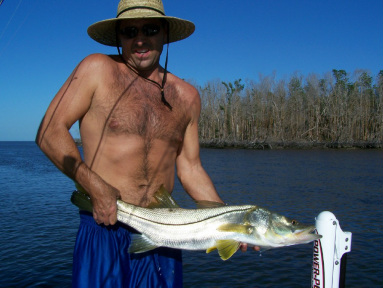
How to catch a snook in Florida:
Most of my big snook were caught with dead bait. I know that seems counter intuitive but predators are as lazy as most of us are. It is a lot easier to have a pizza delivered than to go through the process of making it ourselves, right?
A snook is no different. They would much rather gobble up a freshly dead pin fish or mullet than chase it around for a while. Dead bait near mangroves can be very effective for getting snook hook ups but they will usually try to cut you off on the oyster covered red mangrove roots. A dead bait under a dock or off the beach in the drop off is another effective way to catch a snook.
I find that when the beach water is milky white with a 2-3 foot swell the snook are most comfortable and will hit just about anything that you throw to them. A flair hawk type of jig casts up current in the trough is a great way to catch snook off of the beach. Any mullet type suspending or topwater lure will also do the trick when the water is milky.
If you are anchored on the flats or near a river mouth, a dead bait can work wonders for your daily snook quota. A circle hook seems to work best and harms the fish less if it is over or under the slot requirements. They seem to prefer whole pin fish, cut mullet and cut lady fish.
Live bait is another very productive way to catch snook. Snook like the tide to be moving and are usually facing into the tide direction. Live mullet, pin fish and pilchards seem to be their favorites. This is especially true when you are drifting the flats. Try to cover the entire water column when drifting. If the water is 6 feet deep or less, maybe you should have a mullet under a cork and a pin fish on a free line. Pin fish usually stay deep and mullet usually stay near the top. If that is not getting any strikes you can switch it up and put the pin fish on the cork and the mullet on the other line with a small split shot on it.
During the rainy season the spillways around the state will be opened to let the fresh water flow into the sea. The falling water must sound like a dinner bell to a hungry snook. Snook love to hunt the spillways for blue gill, shell crackers and any other hapless pan fish that are sucked out of the spillway. A blue gill on a free line is irresistible to a ravenous snook.
How to catch snook is with artificials. A soft plastic with a jig head can be a deadly combination. For whatever reason, snook like white and red. I have never seen a fish with a red head and a white body but snook seem to love that combination. The snook in the picture above was caught by casting a 1/4 ounce red headed jig head and a white swimming shad body into a school of nervous pilchards.
Casting an artificial shrimp or a suspending mullet lure into a school of mullet is usually irresistible to the snook who are surely lurking underneath the school. Snook will also hit silver and gold spoons. Another great lure casting location is in the trough; along the beach; with the current; at first light. When the snook are down deep around bridge pilings or in the inlets a 1 1/2 oz jig bounced off of the bottom can be deadly.
During sunset, sunrise or on a cloudy day a top water lure can be very effective. This does not mean that you can't try a top water lure on a bright sunny day at noon but typically the results will be better in lower light conditions. A top water lure also works well in extremely shallow water when your jigs and other baits are only catching sea grass.
See more how to catch snook fishing Florida.
Most of my big snook were caught with dead bait. I know that seems counter intuitive but predators are as lazy as most of us are. It is a lot easier to have a pizza delivered than to go through the process of making it ourselves, right?
A snook is no different. They would much rather gobble up a freshly dead pin fish or mullet than chase it around for a while. Dead bait near mangroves can be very effective for getting snook hook ups but they will usually try to cut you off on the oyster covered red mangrove roots. A dead bait under a dock or off the beach in the drop off is another effective way to catch a snook.
I find that when the beach water is milky white with a 2-3 foot swell the snook are most comfortable and will hit just about anything that you throw to them. A flair hawk type of jig casts up current in the trough is a great way to catch snook off of the beach. Any mullet type suspending or topwater lure will also do the trick when the water is milky.
If you are anchored on the flats or near a river mouth, a dead bait can work wonders for your daily snook quota. A circle hook seems to work best and harms the fish less if it is over or under the slot requirements. They seem to prefer whole pin fish, cut mullet and cut lady fish.
Live bait is another very productive way to catch snook. Snook like the tide to be moving and are usually facing into the tide direction. Live mullet, pin fish and pilchards seem to be their favorites. This is especially true when you are drifting the flats. Try to cover the entire water column when drifting. If the water is 6 feet deep or less, maybe you should have a mullet under a cork and a pin fish on a free line. Pin fish usually stay deep and mullet usually stay near the top. If that is not getting any strikes you can switch it up and put the pin fish on the cork and the mullet on the other line with a small split shot on it.
During the rainy season the spillways around the state will be opened to let the fresh water flow into the sea. The falling water must sound like a dinner bell to a hungry snook. Snook love to hunt the spillways for blue gill, shell crackers and any other hapless pan fish that are sucked out of the spillway. A blue gill on a free line is irresistible to a ravenous snook.
How to catch snook is with artificials. A soft plastic with a jig head can be a deadly combination. For whatever reason, snook like white and red. I have never seen a fish with a red head and a white body but snook seem to love that combination. The snook in the picture above was caught by casting a 1/4 ounce red headed jig head and a white swimming shad body into a school of nervous pilchards.
Casting an artificial shrimp or a suspending mullet lure into a school of mullet is usually irresistible to the snook who are surely lurking underneath the school. Snook will also hit silver and gold spoons. Another great lure casting location is in the trough; along the beach; with the current; at first light. When the snook are down deep around bridge pilings or in the inlets a 1 1/2 oz jig bounced off of the bottom can be deadly.
During sunset, sunrise or on a cloudy day a top water lure can be very effective. This does not mean that you can't try a top water lure on a bright sunny day at noon but typically the results will be better in lower light conditions. A top water lure also works well in extremely shallow water when your jigs and other baits are only catching sea grass.
See more how to catch snook fishing Florida.
The video above shows you how to catch a snook in Florida.
The video above shows you the best and worst water temperatures to catch a snook when fishing in Florida.
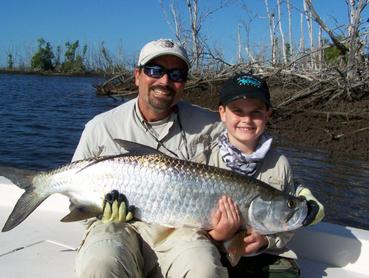
How to catch a tarpon in Florida:
Tarpon are one of those fish that seem to have split personalities. If you have any tarpon friends, I am sorry if I offended you but it is true. There are days that tarpon will hit anything that you throw at them. You can catch them with top water plugs, jigs, live bait or dead bait. BUT there are other days where you are literally surrounded by tarpon and they ignore every offering that you make to them. They will come right up to the sexiest most delicious looking pilchard in the sea and knock it out of the way with their nose in the air.
Most of my big tarpon where caught with dead bait on the bottom. Tarpon seem like they would much rather scavenge than chase their prey around. Tarpon also love to eat their cousins the lady fish. A dead mullet, pin fish and even catfish will also work as long as you cut the head off and break the spines off. The key to this strategy is having a big enough dead bait that the hard head and sail catfish can't swallow whole. It takes a tarpon a little longer to find a dead bait than it does for a catfish to find it.
My favorite live bait for tarpon is the lady fish followed closely by a mullet. A lighter leader will get you more hits so go with as light of a pound test as possible. If the tarpon are three feet or less you can usually get away with a 20-30 pound leader. If the tarpon are three or four feet long you can usually use 40-50 pound test. Tarpon larger than four feet will usually require at least a 60-80 pound test if you plan on getting them to the boat.
Tarpon will also hunt the spillways along with the snook. They are fresh water tolerant just like the snook and will destroy any blue gill or shell crackers that wash out of the spillways. If you free line a live blue gill tossed to the edge of the foam you will usually find a willing diner within minutes. A blue gill under a float will usually work very well too.
How to catch a tarpon with lures- Tarpon are often the target species for many Florida fly fisherman on the flats and in the back country areas. Other fisherman like to throw plugs into mullet schools to catch the tarpon that are usually harassing the schools along their migration routes in the intracoastal waterways and along the beaches. One of the great things about tarpon cruising the beach is their proximity to the shore line. They are usually close enough to cast to from the beach. Larger jigs with soft bodies will also work well in deeper cuts and turning basins. My buddy and his son landed the tarpon in the picture above on a scented swimming mullet bait with a red 1/4 oz jig head cast to a rolling tarpon at an Everglades river mouth.
See the how to catch a tarpon fishing Florida page to learn more.
Tarpon are one of those fish that seem to have split personalities. If you have any tarpon friends, I am sorry if I offended you but it is true. There are days that tarpon will hit anything that you throw at them. You can catch them with top water plugs, jigs, live bait or dead bait. BUT there are other days where you are literally surrounded by tarpon and they ignore every offering that you make to them. They will come right up to the sexiest most delicious looking pilchard in the sea and knock it out of the way with their nose in the air.
Most of my big tarpon where caught with dead bait on the bottom. Tarpon seem like they would much rather scavenge than chase their prey around. Tarpon also love to eat their cousins the lady fish. A dead mullet, pin fish and even catfish will also work as long as you cut the head off and break the spines off. The key to this strategy is having a big enough dead bait that the hard head and sail catfish can't swallow whole. It takes a tarpon a little longer to find a dead bait than it does for a catfish to find it.
My favorite live bait for tarpon is the lady fish followed closely by a mullet. A lighter leader will get you more hits so go with as light of a pound test as possible. If the tarpon are three feet or less you can usually get away with a 20-30 pound leader. If the tarpon are three or four feet long you can usually use 40-50 pound test. Tarpon larger than four feet will usually require at least a 60-80 pound test if you plan on getting them to the boat.
Tarpon will also hunt the spillways along with the snook. They are fresh water tolerant just like the snook and will destroy any blue gill or shell crackers that wash out of the spillways. If you free line a live blue gill tossed to the edge of the foam you will usually find a willing diner within minutes. A blue gill under a float will usually work very well too.
How to catch a tarpon with lures- Tarpon are often the target species for many Florida fly fisherman on the flats and in the back country areas. Other fisherman like to throw plugs into mullet schools to catch the tarpon that are usually harassing the schools along their migration routes in the intracoastal waterways and along the beaches. One of the great things about tarpon cruising the beach is their proximity to the shore line. They are usually close enough to cast to from the beach. Larger jigs with soft bodies will also work well in deeper cuts and turning basins. My buddy and his son landed the tarpon in the picture above on a scented swimming mullet bait with a red 1/4 oz jig head cast to a rolling tarpon at an Everglades river mouth.
See the how to catch a tarpon fishing Florida page to learn more.
The video above shows you how to catch a tarpon in Florida.
The video above shows you the best and worst water temperatures when fishing for tarpon in Florida.
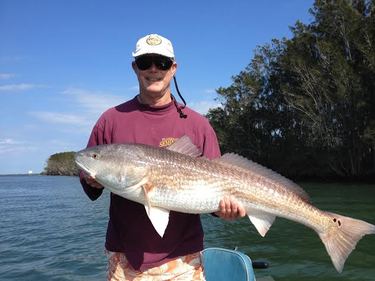
How to catch a red fish in Florida:
Red fish (a.k.a. red drum) are great to catch and will usually eat just about anything that you throw at them. If you can find, foraging reds on the flats you will most likely catch one. They can be spooky at times but if you can get in front of the schools you will probably be eating fresh, blackened red fish for dinner that night.
Most of my big reds were caught using live shrimp or live pin fish. You can free line them; put a split shot on in the case of the shrimp; or put them under a float and get fantastic results. Red fish have an excellent sense of smell and seem to use this sense more than sight. So when it comes to choosing a red fish bait; the stinkier the better.
As mentioned before, red fish have a very evolved olfactory system which is why fresh dead bait works so well. My buddy caught the monster red in the picture above with a small bluefish that was cut in half. It was caught in the intracoastal waterway just a little bit north of Sebastian. You have to use a large bait or the catfish will take it before the reds can find it.
If you are anchored up, take a recently dead pin fish, mullet or cut lady fish and send it near the mangroves and you have a great chance of catching a red. If you are anchored out on the flats send one off of the bow and one off of the stern. That gives you room to throw jigs or spoons for them in between your other two lines.
How to catch a redfish with lures- They seem to love scented soft baits on a jig head. Usually you will want to have some light colored baits and some root beer and darker colored soft baits in your tackle box. When I am fishing with a buddy I make sure to use whatever color they are not using to see which one is producing the best on that day. They also like gold spoons better than silver spoons. A nice weedless gold spoon can create red fish catching nirvana if the conditions are right. Reds will also hit spinner baits with gold blades so break out your large mouth bass lures and bring them to the mud flats.
See how to catch a redfish fishing Florida to learn more.
Red fish (a.k.a. red drum) are great to catch and will usually eat just about anything that you throw at them. If you can find, foraging reds on the flats you will most likely catch one. They can be spooky at times but if you can get in front of the schools you will probably be eating fresh, blackened red fish for dinner that night.
Most of my big reds were caught using live shrimp or live pin fish. You can free line them; put a split shot on in the case of the shrimp; or put them under a float and get fantastic results. Red fish have an excellent sense of smell and seem to use this sense more than sight. So when it comes to choosing a red fish bait; the stinkier the better.
As mentioned before, red fish have a very evolved olfactory system which is why fresh dead bait works so well. My buddy caught the monster red in the picture above with a small bluefish that was cut in half. It was caught in the intracoastal waterway just a little bit north of Sebastian. You have to use a large bait or the catfish will take it before the reds can find it.
If you are anchored up, take a recently dead pin fish, mullet or cut lady fish and send it near the mangroves and you have a great chance of catching a red. If you are anchored out on the flats send one off of the bow and one off of the stern. That gives you room to throw jigs or spoons for them in between your other two lines.
How to catch a redfish with lures- They seem to love scented soft baits on a jig head. Usually you will want to have some light colored baits and some root beer and darker colored soft baits in your tackle box. When I am fishing with a buddy I make sure to use whatever color they are not using to see which one is producing the best on that day. They also like gold spoons better than silver spoons. A nice weedless gold spoon can create red fish catching nirvana if the conditions are right. Reds will also hit spinner baits with gold blades so break out your large mouth bass lures and bring them to the mud flats.
See how to catch a redfish fishing Florida to learn more.
The video above shows you how to catch a red fish in Florida.
The video above shows you the best and worst water temperatures to catch a redfish.
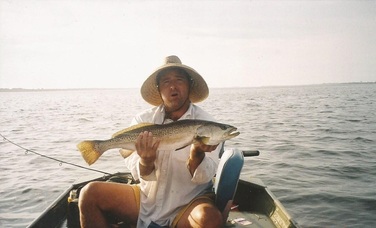
How to catch a spotted seatrout in Florida:
Spotted sea trout are very common on clean water grass flats and around oyster bars. They aren't very good fighters until they get around 20+ inches in length but they can be fun on light tackle. If you use 6-8 pound test and a light reel they can be a blast to catch. You know when you have a trout on because 9 out of 10 times they will come straight to the top and shake their heads to dislodge your hook.
Trout love live bait. Use live shrimp, pilchards or any white bait under a popping cork and you can limit out before you know it if the water isn't too cold. Free lining works well too but it is easier to fish with the corks. A bright and loud popping cork with 18 to 24 inches of line between the hook and the cork will usually do the trick. The gator trout in the picture above was caught by free lining a live pilchard in about 4 feet of water on a 1/0 circle hook.
The largest trout that I have ever caught was on a 6 inch piece of cut mullet near the mangroves with an incoming tide. That bait was supposed to catch a red but I'll take an 8 pound trout too. They will also pick up a dead pin fish on the bottom.
How to catch a trout using lures- They will crush a top water plug early and late in the day. Big plugs often catch big gator trout so don't be afraid to throw your biggest inshore plug at them. They also like jigs with soft plastic tails. Most of mine are caught with a red jig head and a white tail or a red head with a root beer tail. But if you are on the west coast of Florida those chartreuse and other bright colors seem to work well. Trout also seem to like gold spoons more than silver spoons for some reason. You can also catch them using spinner baits when the bite is hot.
See the how to catch a spotted sea trout fishing Florida page to learn more.
Spotted sea trout are very common on clean water grass flats and around oyster bars. They aren't very good fighters until they get around 20+ inches in length but they can be fun on light tackle. If you use 6-8 pound test and a light reel they can be a blast to catch. You know when you have a trout on because 9 out of 10 times they will come straight to the top and shake their heads to dislodge your hook.
Trout love live bait. Use live shrimp, pilchards or any white bait under a popping cork and you can limit out before you know it if the water isn't too cold. Free lining works well too but it is easier to fish with the corks. A bright and loud popping cork with 18 to 24 inches of line between the hook and the cork will usually do the trick. The gator trout in the picture above was caught by free lining a live pilchard in about 4 feet of water on a 1/0 circle hook.
The largest trout that I have ever caught was on a 6 inch piece of cut mullet near the mangroves with an incoming tide. That bait was supposed to catch a red but I'll take an 8 pound trout too. They will also pick up a dead pin fish on the bottom.
How to catch a trout using lures- They will crush a top water plug early and late in the day. Big plugs often catch big gator trout so don't be afraid to throw your biggest inshore plug at them. They also like jigs with soft plastic tails. Most of mine are caught with a red jig head and a white tail or a red head with a root beer tail. But if you are on the west coast of Florida those chartreuse and other bright colors seem to work well. Trout also seem to like gold spoons more than silver spoons for some reason. You can also catch them using spinner baits when the bite is hot.
See the how to catch a spotted sea trout fishing Florida page to learn more.
The video above shows you how to catch a spotted sea trout in Florida.
The video above shows the best and worst water temperatures to catch a spotted sea trout.
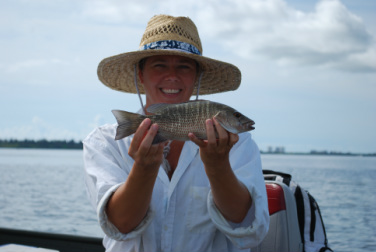
How to catch a snapper in Florida:
Mangrove snappers (aka. gray snappers, mangos) like this one are very common in South Florida waters. Juvenile snappers stay mostly inshore in tidal creeks, mangroves and estuaries until they get to about 2 or 3 pounds and then they head offshore or nearshore to reefs and wrecks to grow up. The adults can be commonly caught in the 8-10 pound range offshore.
Mangrove snappers like live or dead bait. Most fisherman use a dead or a live shrimp cast to a dock, mangrove shoreline, oyster bar, the rocks around an inlet or any structure that is holding mangos. They will also eat fiddler crabs and small white baits like a pilchard or a sardine. The snapper in the picture above ate a small pinfish under a popping cork where an oyster bar drops off and turns to sea grass.
They will also eat shrimp tipped feather jigs, gold and silver spoons and scented shrimp plastic baits with a small jig head. Most of the snapper of mine were caught on a red jig head and a white scented soft bait. The shrimp shape and the swimming bait fish shape both seem to work pretty well. They will also hit a small minnow type suspending lures as well. A small feather jig tipped with a piece of shrimp will also produce plenty of mangos.
Mangrove snappers (aka. gray snappers, mangos) like this one are very common in South Florida waters. Juvenile snappers stay mostly inshore in tidal creeks, mangroves and estuaries until they get to about 2 or 3 pounds and then they head offshore or nearshore to reefs and wrecks to grow up. The adults can be commonly caught in the 8-10 pound range offshore.
Mangrove snappers like live or dead bait. Most fisherman use a dead or a live shrimp cast to a dock, mangrove shoreline, oyster bar, the rocks around an inlet or any structure that is holding mangos. They will also eat fiddler crabs and small white baits like a pilchard or a sardine. The snapper in the picture above ate a small pinfish under a popping cork where an oyster bar drops off and turns to sea grass.
They will also eat shrimp tipped feather jigs, gold and silver spoons and scented shrimp plastic baits with a small jig head. Most of the snapper of mine were caught on a red jig head and a white scented soft bait. The shrimp shape and the swimming bait fish shape both seem to work pretty well. They will also hit a small minnow type suspending lures as well. A small feather jig tipped with a piece of shrimp will also produce plenty of mangos.
The video above shows you how to catch a mangrove snapper in Florida.
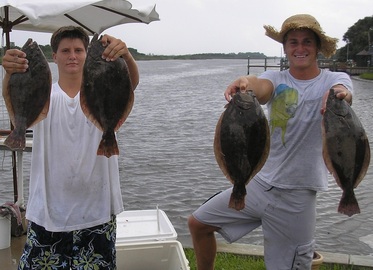
How to catch a flounder in Florida:
Flounder start life looking like a normal fish but as they mature one of their eyes migrates to one side to help them live their new existence as a bottom dwelling predator. Flounder can be found near most structure as long as there is sand for them to bury under. This is for their protection and so that they can ambush their prey. Flounder prefer live bait and they love shrimp and small fish.
The best places to find flounder are in and around inlets as they lie in wait for passing prey items to be brought to them by the current. The same is true for docks. Docks adjacent to grass flats with a sandy bottom are a very good place to target flounder. Fishing piers tend to also hold a decent amount of flounder during most of the year in Florida. Another place to find them is around offshore wrecks and reefs.
Flounder are one of those fish that fisherman often overlook for some reason. They are extremely tasty once you learn how to properly fillet them. Their meat is light, flaky and very mild to the taste buds. The flounder above were caught by my nephew and his good buddy using a flounder rig off of an offshore wreck outside of Matanzas Inlet. A flounder rig is basically a hook with a sinker secured 18 or so inches up the line to allow your bait to move freely.
How to catch a flounder with lures-Flounder will readily eat lures that are presented near their ambush points. A jig bounced on the sandy bottom under a dock is practically irresistible to a hungry flounder. Scented imitation shrimp baits are especially effective. They will swim up from their hiding spots to hit an artificial swimming bait too as long as it is within a foot or two of the bottom. I have caught them with everything from a small rattle trap fished near the bottom to zara spooks fishing in real shallow mudflats and grass flats.
Go to how to catch a flounder fishing Florida to learn more.
Flounder start life looking like a normal fish but as they mature one of their eyes migrates to one side to help them live their new existence as a bottom dwelling predator. Flounder can be found near most structure as long as there is sand for them to bury under. This is for their protection and so that they can ambush their prey. Flounder prefer live bait and they love shrimp and small fish.
The best places to find flounder are in and around inlets as they lie in wait for passing prey items to be brought to them by the current. The same is true for docks. Docks adjacent to grass flats with a sandy bottom are a very good place to target flounder. Fishing piers tend to also hold a decent amount of flounder during most of the year in Florida. Another place to find them is around offshore wrecks and reefs.
Flounder are one of those fish that fisherman often overlook for some reason. They are extremely tasty once you learn how to properly fillet them. Their meat is light, flaky and very mild to the taste buds. The flounder above were caught by my nephew and his good buddy using a flounder rig off of an offshore wreck outside of Matanzas Inlet. A flounder rig is basically a hook with a sinker secured 18 or so inches up the line to allow your bait to move freely.
How to catch a flounder with lures-Flounder will readily eat lures that are presented near their ambush points. A jig bounced on the sandy bottom under a dock is practically irresistible to a hungry flounder. Scented imitation shrimp baits are especially effective. They will swim up from their hiding spots to hit an artificial swimming bait too as long as it is within a foot or two of the bottom. I have caught them with everything from a small rattle trap fished near the bottom to zara spooks fishing in real shallow mudflats and grass flats.
Go to how to catch a flounder fishing Florida to learn more.
The video above shows you how to catch a flounder in Florida.
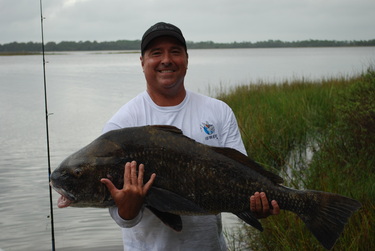
How to catch a black drum in Florida:
Black drum are the largest member of the drum family that includes red drum (redfish) and the spotted sea trout. These fish can often be seen rooting around oyster bars for shrimp, mud crabs, marine worms and fish. They will often give their whereabouts away by tailing in shallow water which leads to their tails sticking out of the water.
Black drum like shrimp and it doesn't seem to matter if they are alive or dead. They have 4 sets of nostrils which leads me to believe that smell is the most important sense for a black drum when it comes to finding food. The black drum in the picture above was caught in about 4 feet of water with a live shrimp on a 1/0 circle hook with 8 pound test monofilament line and a 20 pound fluorocarbon leader. Clam strips, fiddler crabs, mud crabs and oysters will also catch their fair share of black drum when used as bait. Clams are especially good because they will stay on the hook better if there are small bait stealers around.
How to catch a black drum using lures- Black drum will also hit gold spoons, scented plastic baits on a jig head, spinner baits and even top water lures but live baits or freshly dead baits work the best in my opinion.
Black drum will usually travel in schools so if you can catch one chances are that you can catch a few more if you do not spook them from the area. The smaller black drum are delicious to eat but once they get to the size of the one in the picture above the meat tends to have quite a few parasitic worms in the meat.
See the what to page to learn more.
Black drum are the largest member of the drum family that includes red drum (redfish) and the spotted sea trout. These fish can often be seen rooting around oyster bars for shrimp, mud crabs, marine worms and fish. They will often give their whereabouts away by tailing in shallow water which leads to their tails sticking out of the water.
Black drum like shrimp and it doesn't seem to matter if they are alive or dead. They have 4 sets of nostrils which leads me to believe that smell is the most important sense for a black drum when it comes to finding food. The black drum in the picture above was caught in about 4 feet of water with a live shrimp on a 1/0 circle hook with 8 pound test monofilament line and a 20 pound fluorocarbon leader. Clam strips, fiddler crabs, mud crabs and oysters will also catch their fair share of black drum when used as bait. Clams are especially good because they will stay on the hook better if there are small bait stealers around.
How to catch a black drum using lures- Black drum will also hit gold spoons, scented plastic baits on a jig head, spinner baits and even top water lures but live baits or freshly dead baits work the best in my opinion.
Black drum will usually travel in schools so if you can catch one chances are that you can catch a few more if you do not spook them from the area. The smaller black drum are delicious to eat but once they get to the size of the one in the picture above the meat tends to have quite a few parasitic worms in the meat.
See the what to page to learn more.
The video above shows you how to catch a black drum fishing Florida.

How to catch a permit in Florida:
Permit are the larger cousin of the pompano. These fish are excellent fighters are are known for their epic first runs once they have realized that they are hooked. They also can grow very large. Some of my friends have caught them up to 30 pounds. These fish are commonly targeted by sight fisherman on the flats but they can also be found offshore on any structure like wrecks, reefs and rock piles. My experience catching permit has always been on the flats in less than 6 feet of water.
Live shrimp has been the most effective bait for me to target permit on the grass flats. Free lining a live shrimp and putting a live shrimp under a cork has been the technique used by me to catch most of my permit. This intracoastal permit was caught off of a sand bar with a live shrimp under a bobber.
My friends that fish the Everglades/Flamingo region of Florida swear by small blue crabs. They say that a 3-4 inch live blue crab hooked on the corner of the carapace on a free line is a deadly combination for would be permit hunters. They will frequent wrecks and rock piles offshore and can be found in decent sized schools.
Dead shrimp on a sinker can be very effective when fishing for permit in the surf. They are often cruising the beaches with their cousins the pompano. Fishing dead shrimp on a sinker on the grass flats will usually lead to catching a pin fish or a catfish but these pesky bait stealers do not frequent the surf zone.
How to catch a permit using lures- My experience catching permit on a lure is limited to a jig head with a scent impregnated tail. A red jig head with a white body seems to work best for me. Many anglers seek out permit using a fly rod. Supposedly that works very well for permit on the flats. The times that I have tried to use a fly rod usually ended with me catching trees, my hat, my shirt and my friends but no fish. So you will have to talk to someone else to learn more about fly fishing for permits.
See the what to page to learn more.
Permit are the larger cousin of the pompano. These fish are excellent fighters are are known for their epic first runs once they have realized that they are hooked. They also can grow very large. Some of my friends have caught them up to 30 pounds. These fish are commonly targeted by sight fisherman on the flats but they can also be found offshore on any structure like wrecks, reefs and rock piles. My experience catching permit has always been on the flats in less than 6 feet of water.
Live shrimp has been the most effective bait for me to target permit on the grass flats. Free lining a live shrimp and putting a live shrimp under a cork has been the technique used by me to catch most of my permit. This intracoastal permit was caught off of a sand bar with a live shrimp under a bobber.
My friends that fish the Everglades/Flamingo region of Florida swear by small blue crabs. They say that a 3-4 inch live blue crab hooked on the corner of the carapace on a free line is a deadly combination for would be permit hunters. They will frequent wrecks and rock piles offshore and can be found in decent sized schools.
Dead shrimp on a sinker can be very effective when fishing for permit in the surf. They are often cruising the beaches with their cousins the pompano. Fishing dead shrimp on a sinker on the grass flats will usually lead to catching a pin fish or a catfish but these pesky bait stealers do not frequent the surf zone.
How to catch a permit using lures- My experience catching permit on a lure is limited to a jig head with a scent impregnated tail. A red jig head with a white body seems to work best for me. Many anglers seek out permit using a fly rod. Supposedly that works very well for permit on the flats. The times that I have tried to use a fly rod usually ended with me catching trees, my hat, my shirt and my friends but no fish. So you will have to talk to someone else to learn more about fly fishing for permits.
See the what to page to learn more.
The video above shows you how to catch a permit fishing Florida.
The video above covers the best and worst water temperatures to catch a permit.
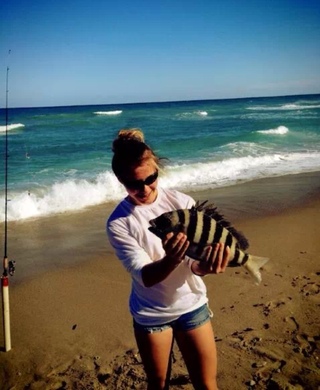
How to catch a sheepshead in Florida:
Sheepshead are renowned bait stealers. They have small mouths and big buck teeth that make them hard to catch. Large mature fish run offshore to mate and can be found on deep structures around the state during that time of year. Most people encounter sheepshead when fishing near inlets, bridges, docks and other structures in and around the intracoastal waterways of Florida. You can also catch them off of the beach near reef outcroppings. Sheepshead are good to eat but are extremely bony and their tough hide requires a resharpening of your filet knife after ever fish or two.
Live shrimp freelined or under a cork works well on the grass flats or near any shoreline structure; fallen trees; mangrove roots; or pilings. Live shrimp with a sinker works very well from the beach if you can find a reef to cast near.
Dead bait like a shrimp or a fiddler crab on a sinker works just fine around structure as well. This sheepshead was caught on a pompano rig with a small piece of frozen shrimp on a 2/0 circle hook.
Sheepshead are renowned bait stealers. They have small mouths and big buck teeth that make them hard to catch. Large mature fish run offshore to mate and can be found on deep structures around the state during that time of year. Most people encounter sheepshead when fishing near inlets, bridges, docks and other structures in and around the intracoastal waterways of Florida. You can also catch them off of the beach near reef outcroppings. Sheepshead are good to eat but are extremely bony and their tough hide requires a resharpening of your filet knife after ever fish or two.
Live shrimp freelined or under a cork works well on the grass flats or near any shoreline structure; fallen trees; mangrove roots; or pilings. Live shrimp with a sinker works very well from the beach if you can find a reef to cast near.
Dead bait like a shrimp or a fiddler crab on a sinker works just fine around structure as well. This sheepshead was caught on a pompano rig with a small piece of frozen shrimp on a 2/0 circle hook.
This video above shows you how to catch a sheepshead in Florida.
The video above is about Winter fishing for sheepshead tips and techniques.

How to catch a shark in Florida:
There are so many kinds of sharks available to be caught in Florida waters. A few common sharks are blacktip sharks, spinner sharks, sandbar sharks, bonnet head sharks, bull sharks, lemon sharks, hammer head sharks........ and the list goes on and on. The bottom line is that if you want to catch a shark, you can do it just about anywhere in Florida waters.
Sharks are voracious feeders and most of the sharks that I have caught over the years have been caught using dead bait on the bottom. If you are beach fishing for sharks, you just have to get your bait out far enough (depending on the tide) for the sharks to find it. My nephew caught this shark by paddling his kayak out past the sand bar to drop his cut mullet bait out where the sharks are. Dusk, dawn and at night are usually the best times to catch sharks.
Most of the sharks that I catch are inshore at or near river mouths or tidal creeks. They seem to like areas that go from a shallow mud flat or sand bar to a deep drop off. This allows them to have the safety of deeper water and surprise prey items as they move off of the relative safety of shallow water.
Sharks will also hit a top water lure. During the annual shark migration in Florida (Nov. through May) great numbers of blacktip and spinner sharks cruise the beaches seeking prey. A top water plug thrown into a school of bait fish will often get hammered by any shark patrolling the school. They will also hit live bait presented under a bobber or balloon of some sort. First and last light are usually the best times to target sharks in the surf.
There are so many kinds of sharks available to be caught in Florida waters. A few common sharks are blacktip sharks, spinner sharks, sandbar sharks, bonnet head sharks, bull sharks, lemon sharks, hammer head sharks........ and the list goes on and on. The bottom line is that if you want to catch a shark, you can do it just about anywhere in Florida waters.
Sharks are voracious feeders and most of the sharks that I have caught over the years have been caught using dead bait on the bottom. If you are beach fishing for sharks, you just have to get your bait out far enough (depending on the tide) for the sharks to find it. My nephew caught this shark by paddling his kayak out past the sand bar to drop his cut mullet bait out where the sharks are. Dusk, dawn and at night are usually the best times to catch sharks.
Most of the sharks that I catch are inshore at or near river mouths or tidal creeks. They seem to like areas that go from a shallow mud flat or sand bar to a deep drop off. This allows them to have the safety of deeper water and surprise prey items as they move off of the relative safety of shallow water.
Sharks will also hit a top water lure. During the annual shark migration in Florida (Nov. through May) great numbers of blacktip and spinner sharks cruise the beaches seeking prey. A top water plug thrown into a school of bait fish will often get hammered by any shark patrolling the school. They will also hit live bait presented under a bobber or balloon of some sort. First and last light are usually the best times to target sharks in the surf.
The video above shows you how to catch a shark in Florida Fishin' Class.
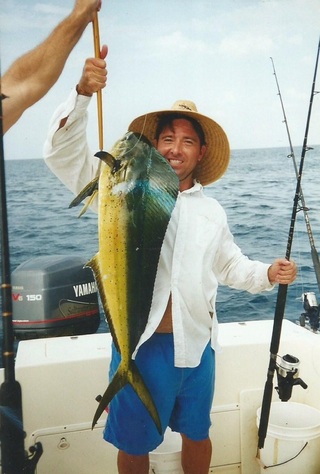
How to catch a dolphin in Florida:
Dolphin are a delicious and super fun fish to catch. Most of this website talks about inshore fishing because the author fishes from a 14 foot jonboat and that is the wrong boat to head out in the Atlantic Ocean trolling for dolphin in. BUT I can usually talk one of my friends with a bigger boat to take me dolphin fishing in the summer. The best time to catch dolphin seems to be May-August but they can be caught year round in the southern part of the state.
Most of the dolphin that I have caught over the years have been by slow trolling sargassum weed lines with live bait or lipped plugs. Dolphin congregate near floating debris in the open ocean. They like to feed on the small fish that find refuge in the flotsam. Once the fish are found the best way to keep them around is to leave a hooked dolphin in the water and the rest of the school will usually stay in the vicinity.
How to catch a dolphin with lures- Once the dolphin are near the boat they will readily eat lures. My favorite is a white bodied plastic shad with a 1/2 ounce red jig head. Those colors have caught dolphin for me from Florida down to Panama. They will also eat a live shrimp or white bait thrown to them. The dolphin in the picture above was caught by sight casting a live greenie to a clump of Sargasso weed just off of the Jupiter Inlet.
Dolphin can also be chummed to the boat by letting out a bunch of live bait out. The bait will usually stay near your boat and you can create your own dinner bell for dolphin and other predators in the area enabling you to sight cast to them. Quite often it is a good idea to sink a bait deeper as the bigger bull dolphins are usually lower in the water column.
Dolphin are a delicious and super fun fish to catch. Most of this website talks about inshore fishing because the author fishes from a 14 foot jonboat and that is the wrong boat to head out in the Atlantic Ocean trolling for dolphin in. BUT I can usually talk one of my friends with a bigger boat to take me dolphin fishing in the summer. The best time to catch dolphin seems to be May-August but they can be caught year round in the southern part of the state.
Most of the dolphin that I have caught over the years have been by slow trolling sargassum weed lines with live bait or lipped plugs. Dolphin congregate near floating debris in the open ocean. They like to feed on the small fish that find refuge in the flotsam. Once the fish are found the best way to keep them around is to leave a hooked dolphin in the water and the rest of the school will usually stay in the vicinity.
How to catch a dolphin with lures- Once the dolphin are near the boat they will readily eat lures. My favorite is a white bodied plastic shad with a 1/2 ounce red jig head. Those colors have caught dolphin for me from Florida down to Panama. They will also eat a live shrimp or white bait thrown to them. The dolphin in the picture above was caught by sight casting a live greenie to a clump of Sargasso weed just off of the Jupiter Inlet.
Dolphin can also be chummed to the boat by letting out a bunch of live bait out. The bait will usually stay near your boat and you can create your own dinner bell for dolphin and other predators in the area enabling you to sight cast to them. Quite often it is a good idea to sink a bait deeper as the bigger bull dolphins are usually lower in the water column.
The video above shows you how to catch a dolphin (mahi mahi) in Florida.
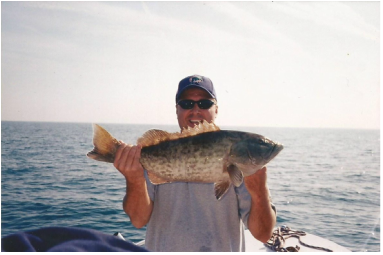
How to catch a grouper in Florida:
Grouper are very fun to catch and are excellent table fare. The seasons and bag limits change quite often so make sure to stay current with the rules before keeping a grouper. Grouper are quite common and there are many species such as gag grouper, goliath grouper, black grouper, snowy grouper, red grouper, scamp grouper, yellow fin grouper...... What they all have in common is the way that they fight and the way that they taste.
BUT whatever you do, DO NOT KEEP A GOLIATH GROUPER!! They are protected and even if you have to pull a small one into your boat to get the hook out do it as quickly as possible and get them back into the water. You cannot bring a big goliath grouper into your boat at all because they will most likely sustain internal injuries and that is considered harvesting by state and federal wildlife officials.
Most of the grouper that I catch are caught inshore. Inshore grouper are just like offshore grouper when it comes to their preference of hang outs. They all seek shelter whether that is a hole under a submerged tree, a hole in a reef, a hole in a sunken wreck, a hole in the mangrove roots, a hole in a mud bank.... You probably have gotten the point that grouper shelter in holes. So to catch a grouper you must entice them out of their holes and once hooked not let them get back into their holes.
Offshore this usually means dropping a live or dead bait offering down to a wreck or a reef. The gag grouper in the picture above was caught about 25 miles offshore of Steinhatchee on a rock pile in about 30 feet of water using a frozen squid offering. The key to catching grouper is getting them out of their holes and keeping them out of their holes. As soon as you feel the hit you must not let that fish get back into its hole. They will cut you off on whatever structure that they are hiding in. The good news is that they tire easily so they will fight very well for a minute or two and then be tired. In other words, if you can keep them from getting back into their hole for two minutes you will be eating grouper later.
Inshore live or dead bait fishing for grouper usually means finding structure and dropping your bait offering to them just like you would offshore. The only difference being that the water depth is usually much less.
How to catch a grouper using lures- My favorite way to catch grouper is using artificial lures. If you can find a group of mangroves adjacent to a deep drop off, quite often there will be grouper in the roots and holes of the drop off. This is when a scented jig or feather jig tipped with a shrimp or white bait dangled near the grouper's hiding spot can yield excellent results. Another great tactic to catch grouper is trolling a lipped diving plug over potential grouper hang outs. They will also hit silver spoons readily. A nice group of bridge pilings is another great place to bounce a jig off of the bottom or troll with deep diving plugs.
Grouper are very fun to catch and are excellent table fare. The seasons and bag limits change quite often so make sure to stay current with the rules before keeping a grouper. Grouper are quite common and there are many species such as gag grouper, goliath grouper, black grouper, snowy grouper, red grouper, scamp grouper, yellow fin grouper...... What they all have in common is the way that they fight and the way that they taste.
BUT whatever you do, DO NOT KEEP A GOLIATH GROUPER!! They are protected and even if you have to pull a small one into your boat to get the hook out do it as quickly as possible and get them back into the water. You cannot bring a big goliath grouper into your boat at all because they will most likely sustain internal injuries and that is considered harvesting by state and federal wildlife officials.
Most of the grouper that I catch are caught inshore. Inshore grouper are just like offshore grouper when it comes to their preference of hang outs. They all seek shelter whether that is a hole under a submerged tree, a hole in a reef, a hole in a sunken wreck, a hole in the mangrove roots, a hole in a mud bank.... You probably have gotten the point that grouper shelter in holes. So to catch a grouper you must entice them out of their holes and once hooked not let them get back into their holes.
Offshore this usually means dropping a live or dead bait offering down to a wreck or a reef. The gag grouper in the picture above was caught about 25 miles offshore of Steinhatchee on a rock pile in about 30 feet of water using a frozen squid offering. The key to catching grouper is getting them out of their holes and keeping them out of their holes. As soon as you feel the hit you must not let that fish get back into its hole. They will cut you off on whatever structure that they are hiding in. The good news is that they tire easily so they will fight very well for a minute or two and then be tired. In other words, if you can keep them from getting back into their hole for two minutes you will be eating grouper later.
Inshore live or dead bait fishing for grouper usually means finding structure and dropping your bait offering to them just like you would offshore. The only difference being that the water depth is usually much less.
How to catch a grouper using lures- My favorite way to catch grouper is using artificial lures. If you can find a group of mangroves adjacent to a deep drop off, quite often there will be grouper in the roots and holes of the drop off. This is when a scented jig or feather jig tipped with a shrimp or white bait dangled near the grouper's hiding spot can yield excellent results. Another great tactic to catch grouper is trolling a lipped diving plug over potential grouper hang outs. They will also hit silver spoons readily. A nice group of bridge pilings is another great place to bounce a jig off of the bottom or troll with deep diving plugs.
The video above shows you how to catch a grouper fishing Florida.
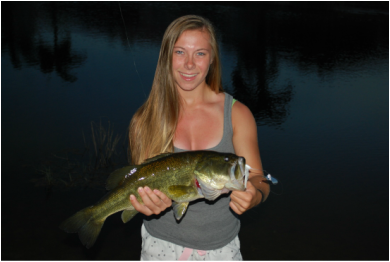
How to catch a largemouth bass in Florida:
The largemouth bass is probably the most sought after fish in Florida and probably all of North America for that matter. The reasons for this are simple. They are super fun to catch. They are very good to eat. And they live in just about every pond, lake, canal, creek or even drainage ditch that has enough water to support them.
The best time to catch largemouth bass in Florida is late February to early April. Bass will start to spawn when the water temperatures reach the mid 60s as long as that temperature does not vary for at least a week. They do not stop spawning until the water temperatures get to about 80 degrees. So depending on what part of Florida you live in, the spawn can start in late December and go through the month of May. This varies based on weather events like El Nino and La Nina but you can get yourself a thermometer to know for sure.
The best live baits for bass are shiners and any of the pan fish (red eared sunfish, bluegill, shell crackers....) set underneath a bobber. A live crawdad will work just fine too. If you can't find live bait, keep in mind that a bass' forage will often change colors during their spawn and you should change your lures up to compensate for that color change. An example is bluegills changing to dark blue/black during their spawn. So use a darker lure when the bluegills are spawning.
Also keep in mind bait size when targeting bass during different seasons. It seems to me that a big shiner or bluegill works better in the winter months than in summer. Spring and summer months tend to favor a downsized bait presentation.
How to catch a bass with lures- The best lures are argued by fishermen all of the time but my favorite is the good ol' Carolina rigged purple plastic worm rigged weed less and worked slowly across the bottom. If the fish are in the bottom layers of the water column the worm will float above the gunk on the bottom (as long as you use floating worms). Bass love this presentation.
If the fish are in the upper part of the water column then my favorite is a white buzz bait and a spinner bait. The largemouth bass in the picture above was caught on a white buzz bait in the shallow pond behind our house right at sunset. I prefer these baits over a top water lures, suspending lures or a crank bait because of the single hooks versus the treble hooks. When the bass are extremely aggressive they will swallow the whole lure and it ends up killing the fish much of the time. So if I am fishing for fun and not food I like to use a single hook set up because it's easier to get unhooked. But if I'm hungry I'll use a crank bait most of the time.
See more How to catch a bass in Florida...
If the bass are in the lily pads or thick vegetation then a weed less frog lure is one of my favorites and gets some amazing strikes. Many fishermen prefer a 2-2 1/2 oz. jig for this set up and 50-60 lb braid. The bass will usually hit the jig just as it breaks through the grass mat or just as you are about to pull it back through the grass mat.
The largemouth bass is probably the most sought after fish in Florida and probably all of North America for that matter. The reasons for this are simple. They are super fun to catch. They are very good to eat. And they live in just about every pond, lake, canal, creek or even drainage ditch that has enough water to support them.
The best time to catch largemouth bass in Florida is late February to early April. Bass will start to spawn when the water temperatures reach the mid 60s as long as that temperature does not vary for at least a week. They do not stop spawning until the water temperatures get to about 80 degrees. So depending on what part of Florida you live in, the spawn can start in late December and go through the month of May. This varies based on weather events like El Nino and La Nina but you can get yourself a thermometer to know for sure.
The best live baits for bass are shiners and any of the pan fish (red eared sunfish, bluegill, shell crackers....) set underneath a bobber. A live crawdad will work just fine too. If you can't find live bait, keep in mind that a bass' forage will often change colors during their spawn and you should change your lures up to compensate for that color change. An example is bluegills changing to dark blue/black during their spawn. So use a darker lure when the bluegills are spawning.
Also keep in mind bait size when targeting bass during different seasons. It seems to me that a big shiner or bluegill works better in the winter months than in summer. Spring and summer months tend to favor a downsized bait presentation.
How to catch a bass with lures- The best lures are argued by fishermen all of the time but my favorite is the good ol' Carolina rigged purple plastic worm rigged weed less and worked slowly across the bottom. If the fish are in the bottom layers of the water column the worm will float above the gunk on the bottom (as long as you use floating worms). Bass love this presentation.
If the fish are in the upper part of the water column then my favorite is a white buzz bait and a spinner bait. The largemouth bass in the picture above was caught on a white buzz bait in the shallow pond behind our house right at sunset. I prefer these baits over a top water lures, suspending lures or a crank bait because of the single hooks versus the treble hooks. When the bass are extremely aggressive they will swallow the whole lure and it ends up killing the fish much of the time. So if I am fishing for fun and not food I like to use a single hook set up because it's easier to get unhooked. But if I'm hungry I'll use a crank bait most of the time.
See more How to catch a bass in Florida...
If the bass are in the lily pads or thick vegetation then a weed less frog lure is one of my favorites and gets some amazing strikes. Many fishermen prefer a 2-2 1/2 oz. jig for this set up and 50-60 lb braid. The bass will usually hit the jig just as it breaks through the grass mat or just as you are about to pull it back through the grass mat.
The video above shows you how to catch a large mouth bass fishing Florida.
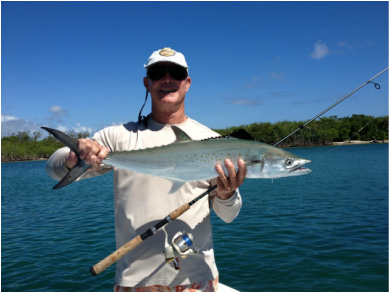
How to catch a King Mackerel (kingfish), Spanish Mackerel or Cero Mackerel:
Mackerel are one of the most fun fish to catch around Florida. These fish will jump and pull above their weight class most of the time. The are migratory for the most part but their are resident groups that will stay around Florida all year. There are two distinct migratory groups. There is a Gulf of Mexico group that moves from Texas to Tampa and the best time to catch them is between November and March. There is also an Atlantic group that travels from North Carolina to Florida and the best time to catch them is between May and August.
All mackerel are very sight oriented hunters. The key to catching these fish is twofold. You should find the water temperatures that they like which is 70-80 degrees. The second thing you will need to find is clean water. They are sight feeders and want to see their prey versus smelling their prey like so many other predatory fish. King mackerel, spanish mackerel and cero mackerel all have extremely sharp teeth. Wire leaders are a must to consistently land a mackerel. Cero mackerel and spanish mackerel can be caught off of the beach or inshore around grass flats and oyster bars if the water temperature and clarity is right. The state record for a cero mackerel is 17 lbs. and the state record for a spanish mackerel is 12 lbs. The state record for a king mackerel is 90 lbs.
The best live baits are usually mullet, sardines, pilchards, anchovies but they will hit just about any fish that will fit in their mouths. Live baits can be trolled or once the mackerel are in the area, sight casting will work just fine too. Don't forget to use a wire leader. The spanish mackerel in the picture was caught using a live pilchard on a 2/0 circle hook.
How to catch a mackerel with lures- The best lures for mackerel are much debated but this fisherman prefers spoons. Any imitation mullet, sardine, pilchard or minnow lure will work just fine too as long as it is fished with a very fast or erratic retrieve. These fish are reaction biters and will slam the flash of your lure before investigating it. They bite first which makes them easy to catch.
Mackerel are one of the most fun fish to catch around Florida. These fish will jump and pull above their weight class most of the time. The are migratory for the most part but their are resident groups that will stay around Florida all year. There are two distinct migratory groups. There is a Gulf of Mexico group that moves from Texas to Tampa and the best time to catch them is between November and March. There is also an Atlantic group that travels from North Carolina to Florida and the best time to catch them is between May and August.
All mackerel are very sight oriented hunters. The key to catching these fish is twofold. You should find the water temperatures that they like which is 70-80 degrees. The second thing you will need to find is clean water. They are sight feeders and want to see their prey versus smelling their prey like so many other predatory fish. King mackerel, spanish mackerel and cero mackerel all have extremely sharp teeth. Wire leaders are a must to consistently land a mackerel. Cero mackerel and spanish mackerel can be caught off of the beach or inshore around grass flats and oyster bars if the water temperature and clarity is right. The state record for a cero mackerel is 17 lbs. and the state record for a spanish mackerel is 12 lbs. The state record for a king mackerel is 90 lbs.
The best live baits are usually mullet, sardines, pilchards, anchovies but they will hit just about any fish that will fit in their mouths. Live baits can be trolled or once the mackerel are in the area, sight casting will work just fine too. Don't forget to use a wire leader. The spanish mackerel in the picture was caught using a live pilchard on a 2/0 circle hook.
How to catch a mackerel with lures- The best lures for mackerel are much debated but this fisherman prefers spoons. Any imitation mullet, sardine, pilchard or minnow lure will work just fine too as long as it is fished with a very fast or erratic retrieve. These fish are reaction biters and will slam the flash of your lure before investigating it. They bite first which makes them easy to catch.
The video above shows you how to catch a spanish, cero or king mackerel fishing Florida.
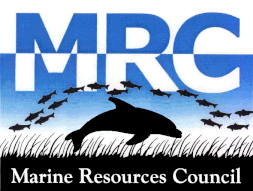
The Conservation Corner
I am sure that we all recognize that if there aren't any fish in the waters where we are, then we can't catch any fish. When I go fishing, I like to catch a bunch of fish and I am sure that you do too.
I am not a political guy but I do love to fish and I do love to be outdoors near, in or on the water. I have watched the Florida fisheries become more and more depleted over the last decade or two and there are ways that we can help to stop that or at the very least slow it down so our grand kids can enjoy fishing like we got to.
Below are a few front line fighters that are fighting the battle to keep the fish populations abundant for us to catch in the bays, estuaries, reefs, lakes and rivers all over Florida.
Check out their websites and if you want to; donate your time; your money; or give them free banner ad space like we do on your websites. Every little bit helps.
The Bonefish and Tarpon Trust is an amazing organization dedicated to the conservation and global enhancement of bonefish, tarpon, permit and their environments. This is another group focused on keeping our fisheries abundant and healthy for generations to come. Check out their website HERE!
The Coastal Conservation Association of Florida is an amazing organization whose mission is to protect the water resources of Florida. They lobby to protect the Florida environment so that fishermen like us can keep catching lots of healthy fish. Check out their website HERE.
The Marine Resource Council is another non-profit organization that has been fighting for the Indian River specifically for more than 30 years. Their mission is to improve the water quality and protect and restore the fish and wildlife resources of the Indian River Lagoon, coastal waters, inshore reefs and the watershed. Check out their website HERE.
I am sure that we all recognize that if there aren't any fish in the waters where we are, then we can't catch any fish. When I go fishing, I like to catch a bunch of fish and I am sure that you do too.
I am not a political guy but I do love to fish and I do love to be outdoors near, in or on the water. I have watched the Florida fisheries become more and more depleted over the last decade or two and there are ways that we can help to stop that or at the very least slow it down so our grand kids can enjoy fishing like we got to.
Below are a few front line fighters that are fighting the battle to keep the fish populations abundant for us to catch in the bays, estuaries, reefs, lakes and rivers all over Florida.
Check out their websites and if you want to; donate your time; your money; or give them free banner ad space like we do on your websites. Every little bit helps.
The Bonefish and Tarpon Trust is an amazing organization dedicated to the conservation and global enhancement of bonefish, tarpon, permit and their environments. This is another group focused on keeping our fisheries abundant and healthy for generations to come. Check out their website HERE!
The Coastal Conservation Association of Florida is an amazing organization whose mission is to protect the water resources of Florida. They lobby to protect the Florida environment so that fishermen like us can keep catching lots of healthy fish. Check out their website HERE.
The Marine Resource Council is another non-profit organization that has been fighting for the Indian River specifically for more than 30 years. Their mission is to improve the water quality and protect and restore the fish and wildlife resources of the Indian River Lagoon, coastal waters, inshore reefs and the watershed. Check out their website HERE.

Send us your photos.
Be part of Team Salt Donkey and send us your fishing photos for publication on our website and Facebook page. Send photos to photos@fishyourassoff.com. Images must not have appeared or been submitted elsewhere.
Make sure to include the names of the people pictured, location of catch, details (ie. it took an hour to reel in; it weighed 100 lbs.; it was at dead low tide...) and the bait and tackle used.
Be part of Team Salt Donkey and send us your fishing photos for publication on our website and Facebook page. Send photos to photos@fishyourassoff.com. Images must not have appeared or been submitted elsewhere.
Make sure to include the names of the people pictured, location of catch, details (ie. it took an hour to reel in; it weighed 100 lbs.; it was at dead low tide...) and the bait and tackle used.
